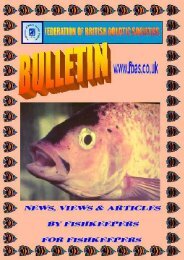Jelly Bean Tetra - Ladigesia roloffi - Federation of British Aquatic ...
Jelly Bean Tetra - Ladigesia roloffi - Federation of British Aquatic ...
Jelly Bean Tetra - Ladigesia roloffi - Federation of British Aquatic ...
You also want an ePaper? Increase the reach of your titles
YUMPU automatically turns print PDFs into web optimized ePapers that Google loves.
this could be a sign <strong>of</strong> a swim bladder disorder. Again further investigation<br />
will lead the fishkeeper to discover that the fish are actually ‘upside-down<br />
catfish’, that swim happily in an inverted position when juvenile, <strong>of</strong>ten<br />
resorting to a more conventional posture as adult fish.<br />
These two examples highlight the need to know your fish!<br />
Knowing your fish starts before you have even purchased them from your<br />
aquatic store. When you read up on the potential size, feeding and water<br />
quality requirements <strong>of</strong> any potential new fish, try to also seek information<br />
about the natural appearance <strong>of</strong> the fish at different stages <strong>of</strong> their life cycle<br />
and their natural ‘normal’ behaviour. Kribensis cichlids (Pelvicachromis<br />
pulcher) for example show a markedly red belly at spawning time, this<br />
could be mistaken for bacterial erythrema. Clown Loaches (Chromobotia<br />
macracanthus), are notorious for the eccentric behaviours. At the <strong>Tetra</strong><br />
fishkeeping helpdesk we hear <strong>of</strong> many who play ‘dead’ and even <strong>of</strong> one<br />
Clown Loach who destroyed its aquarium by pulling out the silicone that<br />
held the glass panels <strong>of</strong> the tank together!<br />
Upon acquiring your fish, you should familiarise yourself with the<br />
individual’s natural appearance and its behaviour. In the first few days in<br />
the tank, your new fish are likely to be very timid and may decline feeding,<br />
however as they settle most common freshwater aquarium inhabitants will<br />
venture out into the tank and respond to feeding.<br />
Notice the swimming patterns <strong>of</strong> your fish, how quickly they eat food and<br />
the method <strong>of</strong> food intake. Feeding time <strong>of</strong>fers an excellent time for a brief<br />
visual health check <strong>of</strong> your fishes.<br />
However, as emphasised above, we must be familiar with ‘normal’<br />
appearance and behaviour <strong>of</strong> healthy fish in order to recognise ‘abnormal’<br />
and thus potential ill health.<br />
Abnormal signs to look out for can be split into behavioural and<br />
morphological deviations from the accepted ‘normal’ state <strong>of</strong> your fish.<br />
Behavioural indicators <strong>of</strong> ill health include gasping for air at the water<br />
surface, a common sign <strong>of</strong> gill disease or water quality problems in most<br />
fishes – in air breathing fishes such as the Lungfish this is perfectly normal<br />
behaviour.<br />
Changes in the swimming activity are a sure sign <strong>of</strong> potential ill health. If a<br />
normally active fish ceases swimming activity, becoming lethargic and<br />
swimming only when disturbed, then this is a strong indicator <strong>of</strong> ill health.<br />
6



